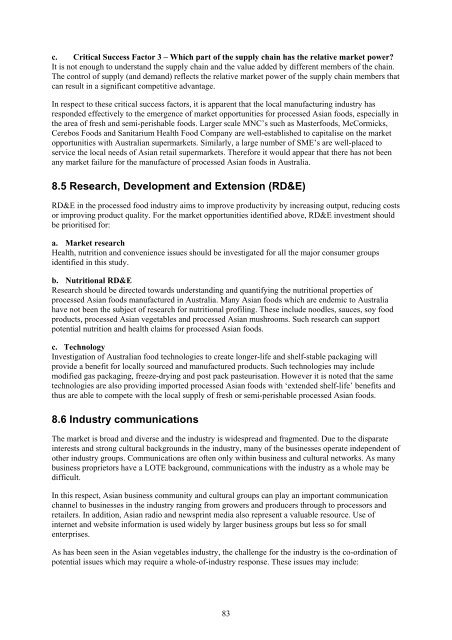Processed Asian Foods in Australia – An update
Processed Asian Foods in Australia – An update
Processed Asian Foods in Australia – An update
You also want an ePaper? Increase the reach of your titles
YUMPU automatically turns print PDFs into web optimized ePapers that Google loves.
c. Critical Success Factor 3 <strong>–</strong> Which part of the supply cha<strong>in</strong> has the relative market power?<br />
It is not enough to understand the supply cha<strong>in</strong> and the value added by different members of the cha<strong>in</strong>.<br />
The control of supply (and demand) reflects the relative market power of the supply cha<strong>in</strong> members that<br />
can result <strong>in</strong> a significant competitive advantage.<br />
In respect to these critical success factors, it is apparent that the local manufactur<strong>in</strong>g <strong>in</strong>dustry has<br />
responded effectively to the emergence of market opportunities for processed <strong>Asian</strong> foods, especially <strong>in</strong><br />
the area of fresh and semi-perishable foods. Larger scale MNC’s such as Masterfoods, McCormicks,<br />
Cerebos <strong>Foods</strong> and Sanitarium Health Food Company are well-established to capitalise on the market<br />
opportunities with <strong>Australia</strong>n supermarkets. Similarly, a large number of SME’s are well-placed to<br />
service the local needs of <strong>Asian</strong> retail supermarkets. Therefore it would appear that there has not been<br />
any market failure for the manufacture of processed <strong>Asian</strong> foods <strong>in</strong> <strong>Australia</strong>.<br />
8.5 Research, Development and Extension (RD&E)<br />
RD&E <strong>in</strong> the processed food <strong>in</strong>dustry aims to improve productivity by <strong>in</strong>creas<strong>in</strong>g output, reduc<strong>in</strong>g costs<br />
or improv<strong>in</strong>g product quality. For the market opportunities identified above, RD&E <strong>in</strong>vestment should<br />
be prioritised for:<br />
a. Market research<br />
Health, nutrition and convenience issues should be <strong>in</strong>vestigated for all the major consumer groups<br />
identified <strong>in</strong> this study.<br />
b. Nutritional RD&E<br />
Research should be directed towards understand<strong>in</strong>g and quantify<strong>in</strong>g the nutritional properties of<br />
processed <strong>Asian</strong> foods manufactured <strong>in</strong> <strong>Australia</strong>. Many <strong>Asian</strong> foods which are endemic to <strong>Australia</strong><br />
have not been the subject of research for nutritional profil<strong>in</strong>g. These <strong>in</strong>clude noodles, sauces, soy food<br />
products, processed <strong>Asian</strong> vegetables and processed <strong>Asian</strong> mushrooms. Such research can support<br />
potential nutrition and health claims for processed <strong>Asian</strong> foods.<br />
c. Technology<br />
Investigation of <strong>Australia</strong>n food technologies to create longer-life and shelf-stable packag<strong>in</strong>g will<br />
provide a benefit for locally sourced and manufactured products. Such technologies may <strong>in</strong>clude<br />
modified gas packag<strong>in</strong>g, freeze-dry<strong>in</strong>g and post pack pasteurisation. However it is noted that the same<br />
technologies are also provid<strong>in</strong>g imported processed <strong>Asian</strong> foods with ‘extended shelf-life’ benefits and<br />
thus are able to compete with the local supply of fresh or semi-perishable processed <strong>Asian</strong> foods.<br />
8.6 Industry communications<br />
The market is broad and diverse and the <strong>in</strong>dustry is widespread and fragmented. Due to the disparate<br />
<strong>in</strong>terests and strong cultural backgrounds <strong>in</strong> the <strong>in</strong>dustry, many of the bus<strong>in</strong>esses operate <strong>in</strong>dependent of<br />
other <strong>in</strong>dustry groups. Communications are often only with<strong>in</strong> bus<strong>in</strong>ess and cultural networks. As many<br />
bus<strong>in</strong>ess proprietors have a LOTE background, communications with the <strong>in</strong>dustry as a whole may be<br />
difficult.<br />
In this respect, <strong>Asian</strong> bus<strong>in</strong>ess community and cultural groups can play an important communication<br />
channel to bus<strong>in</strong>esses <strong>in</strong> the <strong>in</strong>dustry rang<strong>in</strong>g from growers and producers through to processors and<br />
retailers. In addition, <strong>Asian</strong> radio and newspr<strong>in</strong>t media also represent a valuable resource. Use of<br />
<strong>in</strong>ternet and website <strong>in</strong>formation is used widely by larger bus<strong>in</strong>ess groups but less so for small<br />
enterprises.<br />
As has been seen <strong>in</strong> the <strong>Asian</strong> vegetables <strong>in</strong>dustry, the challenge for the <strong>in</strong>dustry is the co-ord<strong>in</strong>ation of<br />
potential issues which may require a whole-of-<strong>in</strong>dustry response. These issues may <strong>in</strong>clude:<br />
83

















